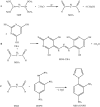Lipid Peroxidation Process in Meat and Meat Products: A Comparison Study of Malondialdehyde Determination between Modified 2-Thiobarbituric Acid Spectrophotometric Method and Reverse-Phase High-Performance Liquid Chromatography
- PMID: 29144423
- PMCID: PMC6150165
- DOI: 10.3390/molecules22111988
Lipid Peroxidation Process in Meat and Meat Products: A Comparison Study of Malondialdehyde Determination between Modified 2-Thiobarbituric Acid Spectrophotometric Method and Reverse-Phase High-Performance Liquid Chromatography
Abstract
The aim of this work was to compare the methods of malondialdehyde detection, as the main secondary product of the lipid peroxidation process, in meat and meat products. Malondialdehyde measurements were performed by two modified methods, the 2-thiobarbituric acid spectrophotometric method and the reverse-phase high-performance liquid chromatography in raw, mechanically-deboned chicken meat and in manufactured frankfurters. The malondialdehyde concentrations measured by the 2-thiobarbituric acid spectrophotometric method were found to be overestimated by more than 25% in raw meat and more than 27% in frankfurters in comparison to the results of reverse-phase high-performance liquid chromatography (p < 0.05). The achieved results showed that the presented modified reverse-phase high-performance liquid chromatography method was more applicable and more accurate for the quantification of malondialdehyde in samples of meat and meat products.
Keywords: derivatization; high-performance liquid chromatography; lipid oxidation; malondialdehyde; meat; meat products; spectrophotometry; thiobarbituric acid.
Conflict of interest statement
The authors declare no conflict of interest.
Figures



Similar articles
-
Malondialdehyde determination in raw and processed meat products by UPLC-DAD and UPLC-FLD.Food Chem. 2019 Nov 15;298:125009. doi: 10.1016/j.foodchem.2019.125009. Epub 2019 Jun 21. Food Chem. 2019. PMID: 31260970
-
Malondialdehyde measurement in oxidized foods: evaluation of the spectrophotometric thiobarbituric acid reactive substances (TBARS) test in various foods.J Agric Food Chem. 2012 Sep 26;60(38):9589-94. doi: 10.1021/jf302451c. Epub 2012 Sep 17. J Agric Food Chem. 2012. PMID: 22950760
-
High-performance liquid chromatographic determination of 1,3-diethyl-2-thiobarbituric acid--malonaldehyde adduct in fish meat.J Chromatogr B Biomed Sci Appl. 1999 Apr 16;726(1-2):313-6. doi: 10.1016/s0378-4347(99)00060-2. J Chromatogr B Biomed Sci Appl. 1999. PMID: 10348202
-
The biological significance of malondialdehyde determination in the assessment of tissue oxidative stress.Life Sci. 1991;48(4):301-9. doi: 10.1016/0024-3205(91)90550-u. Life Sci. 1991. PMID: 1990230 Review.
-
Quantification of malondialdehyde by HPLC-FL - application to various biological samples.Biomed Chromatogr. 2015 Jan;29(1):41-6. doi: 10.1002/bmc.3361. Epub 2014 Oct 30. Biomed Chromatogr. 2015. PMID: 25355691 Review.
Cited by
-
Insight into Pelargonium odoratissimum Essential Oil Preservative Properties Effect on Ground Beef.Foods. 2024 Oct 7;13(19):3181. doi: 10.3390/foods13193181. Foods. 2024. PMID: 39410216 Free PMC article.
-
The effect of different sterilization methods on the shelf life and physicochemical indicators of fermented pork jerky.Front Nutr. 2023 Oct 20;10:1240749. doi: 10.3389/fnut.2023.1240749. eCollection 2023. Front Nutr. 2023. PMID: 37927503 Free PMC article.
-
Evaluation of quality parameters of fried chicken chips containing different levels of roasted chickpea and corn flour.Poult Sci. 2025 Apr;104(4):104905. doi: 10.1016/j.psj.2025.104905. Epub 2025 Feb 25. Poult Sci. 2025. PMID: 40064101 Free PMC article.
-
Effect of Fruit Powders as Natural Alternatives to Sodium Nitrite on Lipid Oxidation in Clean-Label Salami.Foods. 2025 Jun 26;14(13):2262. doi: 10.3390/foods14132262. Foods. 2025. PMID: 40647014 Free PMC article.
-
Goji Berry (Lycium Barbarum L.) Carotenoids Enrichment through 'Green' Extraction Method Improves Oxidative Stability and Maintains Fatty Acids of Yak Ghee with Microwave Heating and Storage.Foods. 2022 Jan 27;11(3):369. doi: 10.3390/foods11030369. Foods. 2022. PMID: 35159520 Free PMC article.
References
-
- Ruban S.W. Lipid peroxidation in muscle foods—An overview. Glob. Vet. 2009;3:509–513.
-
- Püssa T., Raudsepp P., Toomik P., Pällin R., Mäeorg U., Kuusik S., Soidla R., Rei M.A. Study of oxidation products of free polyunsaturated fatty acids in mechanically deboned meat. J. Food Compost. Anal. 2009;22:307–314. doi: 10.1016/j.jfca.2009.01.014. - DOI
-
- Bigolin J., Weber C., Alfaro A. Lipid oxidation in mechanically deboned chicken meat: Effect of the addition of different agents. Food Nutr. Sci. 2013;4:219–223. doi: 10.4236/fns.2013.48A027. - DOI
-
- Trindade M.A., Felício P.E., Castillo C.J.C. Mechanically separated meat of broiler breeder and white layer spent hens. Sci. Agric. 2004;61:234–239. doi: 10.1590/S0103-90162004000200018. - DOI
-
- Barriuso B., Astiasarán I., Ansorena D. A review of analytical methods measuring lipid oxidation status in foods: A challenging task. Eur. Food Res. Technol. 2013:1–15. doi: 10.1007/s00217-012-1866-9. - DOI
Publication types
MeSH terms
Substances
LinkOut - more resources
Full Text Sources
Other Literature Sources

